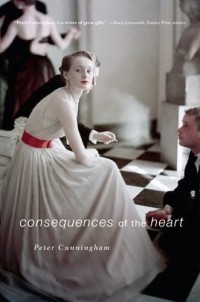Consequences of the Heart by Peter Cunningham
 Saturday, May 28, 2011 at 5:02AM
Saturday, May 28, 2011 at 5:02AM 
First published in the UK in 1998; republished by GemmaMedia on May 4, 2011
On the strength of the only two Peter Cunningham novels I've read (this one and The Sea and the Silence), I have become a fan. Cunningham has written some thrillers and there are elements of a sedate literary thriller in Consequences of the Heart, but it is also a love story, a war story, and a generational story of two Irish families. Ultimately, this novel defies categorization other than to say it's a really good read.
Chud Conduit (sometimes known as Chud Church) is a bit of a cad. He has a gambling addiction, a lifelong problem with debt, and a chronic inability to keep his hands off other men's wives (and to be faithful to his own). His life in the small town of Monument, Ireland is inextricably tied with those of his childhood friends, Jack Santry and Rosa Bensey. In 1938, while they are coming of age, the three-way friendship leads Chud to the first defining moment of his life, the nature of which is slowly disclosed as the novel progresses, although the full truth is not revealed until the last page.
After spending some time in a Catholic reformatory, Chud takes a civilian job that leads to a position in the military. He rejoins Jack (who has become a colonel in the Santry family tradition of wartime service) and together they are part of the invading force on D-Day, where Jack's defining moment occurs -- one that, again, does not become clear until later in the story. Jack, Chud, and Rosa continue a difficult and evolving friendship after the war, leading Chud to commit a new life-defining act for the sake of Jack and Rosa.
I apologize for being a bit vague in that synopsis but I don't want to spoil what is quite a remarkable story. It is the story of Chud's life, summarized from interview transcripts that he has edited and arranged in twelve binders. The story begins with Chud's grandfather in the 1890's and ends with the marriage of Jack's granddaughter in 1999, save for a brief concluding chapter that takes place a year later. No synopsis could do justice to the rich tale that Chud tells. The pages are dense with information. Characters come and go, but Chud, Jack, and Rosa are the constants. Most of the novel is written in the first person from Chud's point of view, with a few passages written in the third person, describing events as Chud imagines them to have occurred. Although the novel covers much ground, the pace is often languid, creating the contemplative feel of a memoir. There are nonetheless times (particularly on D-Day) when action is intense and dramatic. Even at its slowest, the story is never dull. At nearly the midway point, when I was beginning to wonder if the novel would be a mostly uneventful chronicle of Chud's life -- a love story or one of love unrequited -- it took an unexpected turn. Dramatic events then began to pile on top of each other without ever reaching the point of melodrama. For the most part, the story feels intensely real.
Family conflicts and buried secrets are familiar turf for novelists, but when Peter Cunningham plows that ground in Consequences of the Heart, he makes it fertile. No matter how many character flaws Chud demonstrates -- and he manages a goodly number -- it's impossible to dislike him. At the very least, Cunningham makes it easy to understand Chud and to empathize with him. The war changed Chud because "if you land at dawn on the shore of a continent and actually take it by force, you are inclined ever afterwards to doubt the merits of caution." Chud is nothing if not incautious; that's one reason he's so likable.
My one quibble concerns Jack's daughter-in-law, who is very angry at Chud for the incident that occurred in 1938. That didn't seem credible to me, given that she wasn't alive when it happened. Her actions and the events that follow at the end of the novel are almost over-the-top, but I forgive Cunningham for that because it makes a good story. An odd story, to be sure, but this tale of lifelong friendships among three people who followed their natures, however unconventional, is one I'll remember.
RECOMMENDED



